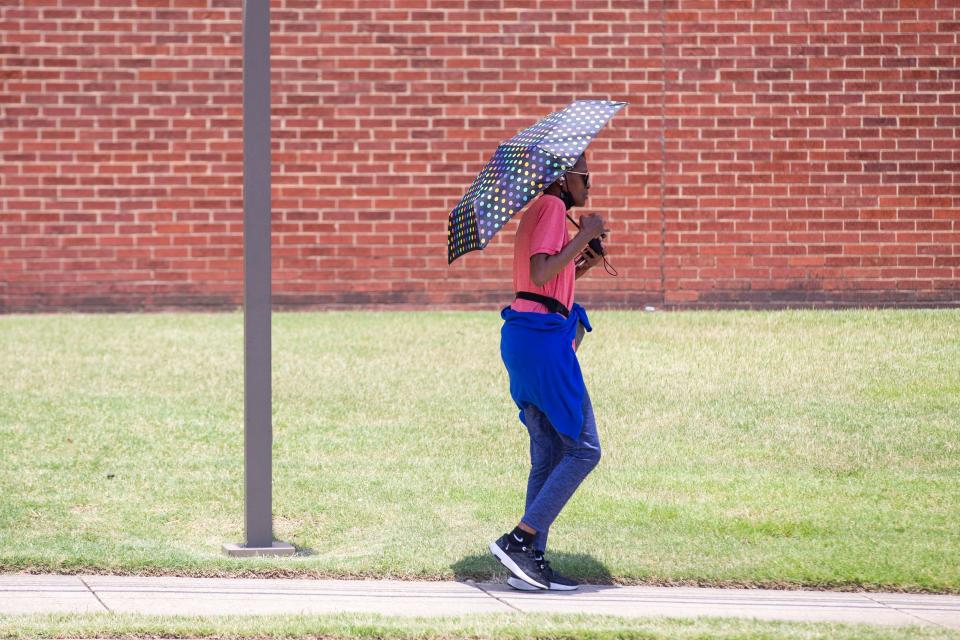Storm, heat danger in US weather forecasts as July Fourth holiday weekend begins
From triple-digit heat to "large hail" and severe thunderstorms, Americans across the country are in for some potentially dangerous weather as they head into the holiday weekend ahead of the Fourth of July, weather forecasters said.
An oppressive heat wave that has already caused more than a dozen deaths in Texas alone has finally been easing up, but the National Oceanic and Atmospheric Administration said Friday that "hazardous heat and humidity is still expected to impact locations across the Southeast through Independence Day."
Plus, Americans in some of the regions where Canadian wildfire smoke has blanketed the sky with a haze will continue to see air quality that is moderate to unhealthy for sensitive groups over the weekend. That, however, is a significant improvement from the last few days.
Here's what to expect from the weather this weekend:
Thunderstorms, hail, flash flooding
A "slow-moving storm system" over this weekend and into early next week could bring heavy rainfall, severe thunderstorms and other dangerous weather this weekend, the NOAA said.
The mid-Mississippi Valley through the central Appalachians could see clusters of thunderstorms, damaging winds, large hail and flash flooding Saturday and Sunday. The storm system is expected to bring similar risks to the Mid-Atlantic between late Sunday and early Tuesday, potentially dampening 4th of July festivities.
The northern Plains region, the Southeast, Northeast and along the Rocky Mountains region may also see rain and thunderstorms on Monday and Tuesday.
US weather watches and warnings map
Heat in the Southeast, California
Hazardous heat and humidity are expected to impact areas of the Southeast this weekend even as temperatures across most of the South should cool to below hazardous. Forecasters also expect "excessive heat" from the Desert Southwest region – the desert areas of Arizona, California, New Mexico and Texas – to the interior of California.
"Heat-related danger remains elevated due to the longevity of this heat wave," the Storm Prediction Center said.
Dry and hot conditions in Southern California across the desert, lower mountains and interior valley are sparking heat advisories and excessive heat warnings through Monday, the National Weather Service in Los Angeles said. Residents are advised to take extra care to avoid leaving children, pets and elderly people in hot cars. Fireworks are also an added fire ignition risk.
Temperatures in California's valleys will reach almost 110 degrees in the hottest points on Saturday, the Storm Prediction Center said. The Desert Southwest will see temperatures in the 110s.
"The risk of heat-related illnesses will be increased through the weekend," the center said.
The forecast for Tucson, Arizona, on Monday is expected to tie a record set in 1989, the National Weather Service said. On average, the hottest time of the year there is in late June and early July, with an average high of 102 degrees. But on Monday, it's expected to hit 111 degrees, the weather service said.
The upper Midwest will also see above-average temperatures over the weekend and going into the holiday, NOAA said.
Excessive heat warnings were in place in some parts of Tennessee through Saturday, and the National Weather Service in Memphis said Friday that two locations in the mid-South were tied for most oppressive heat Friday afternoon: Tunica, Mississippi, and Union City, Tennessee, with a heat index of 119 degrees.

Will hazy air impact fireworks viewing?
Forecasters said the poor air quality from Canadian wildfires could even impact the visibility of fireworks shows in parts of the United States. Some improvement was expected by Sunday and Monday in the Midwest and along the East Coast, but the smoke could get bad again in the Northeast by July 4 as winds come in from the north, NOAA said.
In Montreal, a fireworks show for Canada Day was cancelled Thursday amid poor air quality from wildfires. Fireworks shows around July 4 are known to known to temporarily hurt air quality because of the toxic particulates they give off.
This article originally appeared on USA TODAY: July 4 weekend weather forecast includes storms, excessive heat

